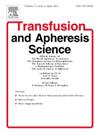eHealth technologies for enhancing blood donor knowledge and behaviour: A PRISMA scoping review
IF 1.4
4区 医学
Q4 HEMATOLOGY
引用次数: 0
Abstract
Background
Blood donor information and education are pivotal in improving knowledge and encouraging positive behaviours towards blood donation. Their impact of utilizing eHealth technologies on self-efficacy presents new opportunities to improve knowledge and encourage people to donate blood.
Objective
A scoping review was conducted to understand the nature of the scientific evidence on improving knowledge and influencing the behaviours of blood donors with eHealth technologies.
Methods
Through a systematic literature search, 6261 published papers were screened, and 20 were reviewed.
Results
eHealth technologies commonly utilized were audio/telephone calls, text messages, emails, audio-visuals, mobile health and smartphone applications, custommade software applications and social media. They were mainly used to disseminate educational and motivational information, send reminders, and enhance the blood donation experience. They significantly impacted the knowledge and behaviours of blood donors, including increased blood donation rates and repeat blood donations, and enhanced blood donor awareness, motivation and behaviours. Facilitators for their effective utilization included personalisation, organisational support, user-centred design and interactivity, clarity and privacy, automation, and cultural acceptance. Barriers included technical, communication, usability, poor access, low awareness and operational limitations.
Conclusions
eHealth technologies could be integrated into traditional blood donor programs even though they are not a panacea for all blood donor recruitment challenges. Targeted research is needed to understand their long-term effectiveness and applicability. Future research should address gaps identified, particularly focusing on the impact of contextual differences and health literacy. Such research will promote the development of more effective and inclusive blood donor engagement programs and technologies.
提高献血者知识和行为的电子卫生技术:PRISMA范围审查
献血者的信息和教育是提高知识和鼓励积极献血行为的关键。他们利用电子健康技术对自我效能感的影响为提高知识和鼓励人们献血提供了新的机会。目的进行范围综述,了解利用电子卫生技术提高献血者知识和影响献血者行为的科学证据的性质。方法通过系统文献检索,筛选已发表论文6261篇,对其中20篇进行综述。结果常用的健康技术有语音/电话、短信、电子邮件、视听、移动健康和智能手机应用、定制软件应用和社交媒体。它们主要用于传播教育和激励信息,发送提醒,增强献血体验。它们显著影响了献血者的知识和行为,包括增加了献血率和重复献血,增强了献血者的意识、动机和行为。促进其有效利用的因素包括个性化、组织支持、以用户为中心的设计和交互性、清晰度和隐私性、自动化和文化接受度。障碍包括技术、沟通、可用性、访问困难、意识不足和操作限制。结论卫生技术可以整合到传统的献血者计划中,尽管它们不是解决所有献血者招募挑战的灵丹妙药。需要有针对性的研究来了解它们的长期有效性和适用性。未来的研究应解决已确定的差距,特别关注背景差异和卫生素养的影响。这类研究将促进制定更有效和更具包容性的献血者参与规划和技术。
本文章由计算机程序翻译,如有差异,请以英文原文为准。
求助全文
约1分钟内获得全文
求助全文
来源期刊
CiteScore
3.60
自引率
5.30%
发文量
181
审稿时长
42 days
期刊介绍:
Transfusion and Apheresis Science brings comprehensive and up-to-date information to physicians and health care professionals involved in the rapidly changing fields of transfusion medicine, hemostasis and apheresis. The journal presents original articles relating to scientific and clinical studies in the areas of immunohematology, transfusion practice, bleeding and thrombotic disorders and both therapeutic and donor apheresis including hematopoietic stem cells. Topics covered include the collection and processing of blood, compatibility testing and guidelines for the use of blood products, as well as screening for and transmission of blood-borne diseases. All areas of apheresis - therapeutic and collection - are also addressed. We would like to specifically encourage allied health professionals in this area to submit manuscripts that relate to improved patient and donor care, technical aspects and educational issues.
Transfusion and Apheresis Science features a "Theme" section which includes, in each issue, a group of papers designed to review a specific topic of current importance in transfusion and hemostasis for the discussion of topical issues specific to apheresis and focuses on the operators'' viewpoint. Another section is "What''s Happening" which provides informal reporting of activities in the field. In addition, brief case reports and Letters to the Editor, as well as reviews of meetings and events of general interest, and a listing of recent patents make the journal a complete source of information for practitioners of transfusion, hemostasis and apheresis science. Immediate dissemination of important information is ensured by the commitment of Transfusion and Apheresis Science to rapid publication of both symposia and submitted papers.

 求助内容:
求助内容: 应助结果提醒方式:
应助结果提醒方式:


